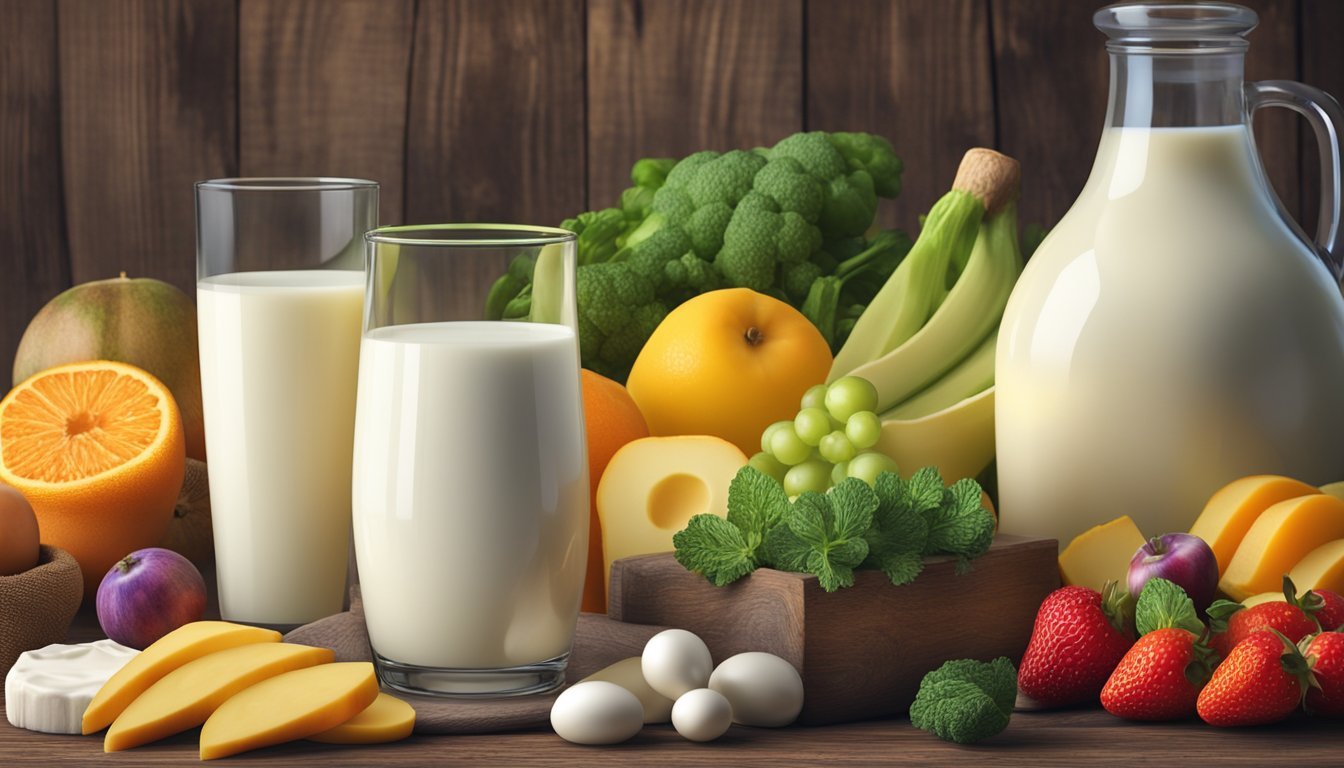The Raw Milk Cleanse
Evaluating Its Role in Detox Trends
The Raw Milk Cleanse has gained attention in wellness circles as a method purported to detoxify the body and provide a wealth of nutrients. Advocates claim that raw milk, which is milk that has not been pasteurized to kill bacteria, contains enzymes that aid in digestion and improve health. Proponents of the cleanse argue that as a complete food, raw milk provides a balance of carbohydrates, fats, and proteins, as well as essential minerals, making it a viable single food source for a limited time.
Detractors, however, raise concerns about the safety of consuming unpasteurized milk due to the risk of contamination by harmful bacteria and question the cleanse's effectiveness. The raw milk diet's roots can be traced back to the early 1900s, where it was used in clinical settings by Mayo Clinic doctors to treat various illnesses, though this historical use is not necessarily indicative of its suitability or safety in modern contexts.
As with any diet or cleanse, it is crucial to consider both the scientific backing and potential risks. The raw milk cleanse continues to be a topic of debate among nutritionists, healthcare providers, and wellness enthusiasts, making it a complex subject with no one-size-fits-all answers.
The concept of The Raw Milk Cleanse aligns with the principles of the ongoing raw milk renaissance and embodies a holistic approach to wellness. As part of the broader raw milk movement advocacy, this cleanse emphasizes the potential benefits of raw milk in supporting overall health and well-being, particularly in the context of raw milk traditional diets.
Advocates of The Raw Milk Cleanse recognize the potential role of raw milk probiotics in promoting gut health and vitality, contributing to a balanced and nourishing dietary regimen. Moreover, the emphasis on raw milk food sovereignty underscores the importance of individuals making informed choices about their food sources and embracing natural, unprocessed dairy products.
As the cleanse gains attention, it contributes to a deeper understanding of the future of raw milk as a valuable component of a balanced lifestyle. By promoting the consumption of raw milk in a mindful and informed manner, this approach fosters a renewed appreciation for unadulterated dairy products and traditional dietary practices, further enriching the wellness landscape.
Understanding Raw Milk
Raw milk is gaining attention for its role in alternative diets and cleanses. This section provides an in-depth look at what raw milk is and how it compares to its pasteurized counterpart.
Definition and Characteristics of Raw Milk
Raw milk refers to milk that has not been pasteurized. Pasteurization is a process where milk is heated to a specific temperature for a set period to kill harmful bacteria. In contrast, raw milk is simply milk straight from the cow, goat, or sheep that has not undergone this heating process.
Characteristics of raw milk include:
Contains natural enzymes
Has not been homogenized
Includes all its original fats, vitamins, and minerals
It is often described as a "complete food" due to its balance of carbohydrates, fats, and proteins, and it may contain beneficial bacteria that proponents suggest can aid digestion.
Raw Milk vs. Pasteurized Milk
When comparing raw and pasteurized milk, the key difference lies in the treatment process:
Aspect Raw Milk Pasteurized Milk Treatment None Heated to kill bacteria Texture Creamier, less uniform Homogenized for uniform consistency Taste May vary according to diet of cow More consistent flavor Nutrients Preserved natural enzymes and bacteria Some nutrients diminished by heat
Advocates for raw milk argue that pasteurization reduces the nutrient content and eliminates beneficial enzymes, potentially aiding in digestion and health. However, health experts caution that unpasteurized milk can harbor harmful bacteria that are destroyed in the pasteurization process.
The consensus in the medical community is that while milk provides essential nutrients regardless of its form, the unpasteurized, raw version may come with health risks that warrant careful consideration.
Nutritional Profile of Raw Milk
Raw milk provides a complex array of nutrients essential for human health, including proteins, fats, and carbohydrates, as well as a diverse range of vitamins and minerals. This section explores the specific nutritional components found in raw milk and how they contribute to the diet.
Vitamins and Minerals Present in Milk
Raw milk is a source of several crucial vitamins and minerals necessary for the body’s optimal functioning. Notable vitamins include Vitamin A, important for vision and immune function, Vitamin B6 and Vitamin B12, key for metabolism and red blood cell production, and Vitamin D, which assists in calcium absorption and bone health. Vitamin C, however, is present in lower amounts compared to processed milks due to its sensitivity to light and heat.
The mineral content in raw milk is substantial, providing essential elements such as:
Calcium: Vital for bone health and enzymatic activity.
Magnesium: Supports muscle and nerve function.
Potassium: Helps maintain fluid balance and is important in nerve signal transmission.
Iron: Critical for oxygen transport in the bloodstream.
These minerals not only support structural components of the body but also play a role in physiological processes.
Proteins, Fats, and Carbohydrates Role in Diet
The protein in raw milk serves as the building block for tissues and is necessary for growth and repair. It typically consists of both whey and casein proteins, which offer the full range of essential amino acids necessary for human health. The health benefits of these proteins are often linked to their unaltered state in raw milk, which some believe makes them more bioavailable.
Fats in raw milk are primarily made up of saturated fats and also include conjugated linoleic acid (CLA) and omega-3 fatty acids. These fats are important for cell membrane structure and the production of certain hormones.
Carbohydrates in milk are found mainly in the form of lactose and play a role in providing dietary energy. The nutritional value of raw milk's natural combination of macronutrients supports the body's diverse physiological needs, contributing to a balanced diet.
Health Benefits and Risks
Raw milk cleanses are gaining attention for their purported health benefits and methods of detoxing. However, this approach comes with significant risks that are important for consumers to understand.
Digestive and Immune Benefits
Proponents claim that raw milk can improve digestive health due to the presence of probiotics—beneficial bacteria that support a healthy gut flora. These probiotics are believed to enhance the digestive system and bolster the immune system. Some people assert that raw milk's natural composition promotes a balance of good bacteria in the gut, which can affect the health of the skin and reduce troubling conditions like eczema.
Potential Allergies and Lactose Intolerance
Nevertheless, approximately 2-3% of children develop a milk protein allergy during their first year of life, and individuals with lactose intolerance may experience adverse reactions to the lactose found in raw milk. Raw milk can also be linked to an aggravation of allergies, contrary to the benefits claimed by raw milk advocates, due to unaltered proteins that can be problematic for some.
Diseases and Foodborne Illness Risks
The consumption of raw milk carries the potential for contamination with harmful bacteria such as Salmonella, Listeria, Campylobacter, E. coli, and the bacteria that cause tuberculosis. These risks are heightened due to the absence of pasteurization, a process that typically eliminates many pathogens in milk products. Food safety is a major concern with raw milk as foodborne illnesses from contaminated dairy are well-documented, thus posing significant health risks to consumers.
The Raw Milk Cleanse
The Raw Milk Cleanse is a dietary routine that focuses on exclusive consumption of raw milk with the aim of detoxifying the body. It asserts various health benefits and operates on principles combining nutrition and historical detoxification practices.
Principles and Procedures
The Raw Milk Cleanse revolves around the principle that raw milk from goat, cow, sheep, camel, or bison is a nutrient-dense food that can provide the body with essential nutrients while purifying it. Participants of the cleanse consume only raw milk for a determined period, typically ranging between a week and over a month. Every two hours, individuals drink a specified amount of raw milk, often 6 ounces, supplemented with certain detox-supporting compounds.
Schedule: Drink 6 ounces of raw milk every two hours
Duration: From 7 to 35 days, based on individual preference and tolerance
Type of Milk: Preferably from organic sources; goat milk is highly recommended
Basis in Detoxification Practices
Historically, as reported by participants, raw milk has been used in various cultural medical practices, including the treatment of tuberculosis by the Mayo Clinic 80 years ago. Its use in cleansing suggests that raw milk's natural composition aids the body in the elimination of toxins. It is considered by advocates to boost levels of glutathione, an antioxidant that supports detoxification at the cellular level.
Historical Use: Raw milk has a background in treating certain diseases
Detoxification Agent: Glutathione production is said to be increased
Cleansing Period: Consumption is exclusive, without other food or drink
Evaluation of Detox Benefits
Supporters of the Raw Milk Cleanse claim it offers multiple detox benefits, including weight loss and improved digestion due to the raw milk's composition. Critics, however, caution against potential risks such as exposure to pathogens. While anecdotal evidence from testimonials suggests benefits such as increased energy and better digestive health, scientific consensus on these claims remains divided, with research on the topic lacking robust support.
Health Benefits: Claims of improved digestion and weight loss
Skepticism: Lack of extensive scientific research to substantiate claims
Risk-Benefit Analysis: Potential risks versus reported health improvements
It is advisable for individuals considering the Raw Milk Cleanse to consult with healthcare professionals and assess their own health conditions prior to beginning the regimen.
Safety Measures and Regulation
In considering the raw milk trend, one must recognize the balance between consumer autonomy and public health. Safety and regulatory compliance are at the forefront of this discussion, given the substantial risks and legal frameworks surrounding raw milk.
Legal Status and FDA Stance
The legal status of raw milk sales varies by state within the United States. Some states permit sales in retail stores, while others only allow purchase directly from the farm or through cow-share agreements. The Food and Drug Administration (FDA) bans the interstate sale of raw milk due to safety concerns, and the Centers for Disease Control and Prevention (CDC) recommends against its consumption, citing the potential presence of disease-causing pathogens.
State Legal Status Regulations State A Retail Sales Allowed Strict Testing Required State B Farm Sales Only Limited Oversight State C Cow-share Only Health Warning Mandated
Best Practices for Raw Milk Consumption
For individuals who choose to consume raw milk, following best practices is crucial to minimize risks. These include:
Purchasing only from reputable sources that follow high standards of hygiene and safety.
Ensuring the milk is rapidly cooled after milking to preserve freshness and slow bacterial growth.
Checking if the farm conducts regular testing for pathogens, such as E. coli, salmonella, and Listeria.
Recognizing that vulnerable populations, like young children, pregnant women, and immunocompromised individuals, are more at risk.
Shelf life is also a consideration; raw milk should be consumed within a narrow time frame compared to pasteurized milk to ensure safety.
Cultural and Historical Perspectives
The debate surrounding raw milk has deep historical roots and is carried forward by strong cultural advocacy and opposing health views.
Traditional Use and Anecdotal Evidence
Historically, raw milk has been a staple in many cultures, serving as a nutritious food source. Its usage traces back to a time before the introduction of pasteurization in the late 19th century. Throughout history, many people consumed raw milk directly from the source without adverse health effects. In contemporary settings, organizations like the Weston A. Price Foundation and online platforms such as realmilk.com champion the consumption of raw milk, referencing its purported health benefits depicted in numerous testimonials. These claims often point to anecdotal evidence of improved digestion and overall health from individuals who have maintained a diet inclusive of raw milk.
Advocacy Groups and Opposing Views
On one hand, the Weston A. Price Foundation and other such advocacy groups present a perspective steeped in historical practices and testimonials—and encourage the return to traditional methods of dairy consumption. These groups argue that raw milk contains beneficial enzymes and bacteria, which they claim may be lost during pasteurization. On the other hand, health authorities and science-based perspectives stress the importance of pasteurization in eliminating harmful pathogens. Both producers and consumers grapple with the implications of these opposing views, often influenced by the cultural significance and history of raw milk. While many support its consumption based on historical usage and anecdotes, scientific and health communities generally caution against potential risks.
FAQs in The Raw Milk Discourse
This section provides clarity on the frequently asked questions regarding raw milk, with an emphasis on dispelling myths and sharing insights from health experts.
Addressing Common Misconceptions
Is raw milk difficult to digest?
Myth: Raw milk is often believed to be hard to digest.
Fact: Many individuals find raw milk easier to digest due to the presence of natural enzymes that are eliminated during pasteurization.
Does raw milk enhance glutathione production?
Claim: It is suggested that raw milk boosts the body's production of glutathione, a potent antioxidant.
Consideration: While some proponents argue this benefit, conclusive evidence is necessary to back this claim.
Can raw milk be a complete food?
Benefit: Raw milk is often praised for its balance of carbohydrates, fats, and proteins, along with minerals.
Advisory: Despite its nutrient content, raw milk should not replace a varied and balanced diet.
Is raw milk linked to digestive issues like diarrhea or constipation?
Risk: There are reports associating raw milk with foodborne illnesses leading to diarrhea.
Caution: Individuals with sensitive systems or compromised immunity should be especially cautious of these potential effects.
Expert Opinions on Frequently Asked Questions
What do experts say about the health benefits of raw milk?
Nutritional Benefits: Experts acknowledge the presence of beneficial nutrients and probiotics in raw milk.
Safety Concerns: They also stress that raw milk may harbor harmful pathogens, warning that its consumption is not risk-free.
How might raw milk impact hydration and circulation?
Hydration: Experts suggest raw milk can contribute to hydration due to its water content.
Circulation: No direct link between raw milk consumption and improved circulation is definitively established in mainstream medical literature.
It is crucial that readers seeking to make informed decisions about the raw milk cleanse or consumption consider both the potential benefits and the safety concerns raised by experts.
Future Prospects and Research
This section explores the scientific trajectory of the raw milk cleanse and its potential implications on health and wellness trends.
Emerging Studies on Raw Milk
Researchers are increasingly interested in the potential health benefits of raw milk. They focus on its probiotic content, which may contribute to gut health and boost the immune system. Future studies could evaluate the role of these probiotics in addressing nutrient deficiencies and improving metabolism. It's crucial, however, to note that raw milk can also pose health risks due to the possible presence of harmful bacteria.
The Road Ahead for The Raw Milk Movement
The raw milk movement is at a crossroads, balancing between die-hard supporters and skeptical health professionals. Ongoing research will be vital in determining whether the trend has a lasting place in diet trends or whether it's a temporary fad. Scientific inquiry continues to scrutinize consumption of raw milk for potential connections to cancer prevention and overall dietary balance. Advocates for raw milk are calling for more controlled studies to cement its place in future dietary guidelines.








